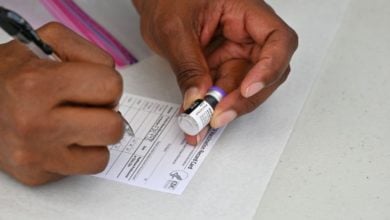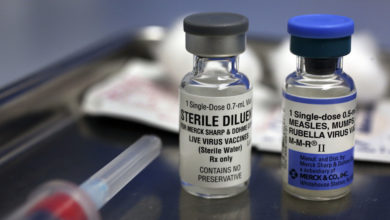China’s Xi Visits a Changed Hong Kong For Handover Anniversary

Neither the headwinds of an incoming typhoon nor a flurry of COVID-19 cases among government officials this week stopped Chinese President Xi Jinping from visiting Hong Kong to mark the 25th anniversary of the city’s July 1 return to Chinese rule, in a tightly choreographed visit intended to reinforce Beijing’s grip over the city.
Xi arrived by high-speed train on Thursday from the mainland tech metropolis Shenzhen, welcomed by supporters waving flags and signs with slogans like: “The Pearl of the Orient retains its romance. The city of vitality has become better than before.”
The trip is Xi’s first outside of mainland China since January 2020, when his zero-COVID policy slammed the country’s borders shut. It’s also his first visit to Hong Kong since hundreds of thousands took the streets in 2019 anti-government protests, posing a challenge to Beijing’s rule of the special administrative region. In the aftermath of the crackdown, many were detained, and opposition lawmakers were jailed. Additionally, newspapers and civil societies groups were shut down.
“Hong Kong has withstood one severe challenge after another, and overcome one hazard after another,” he said in a brief speech when he arrived. “After the storm, Hong Kong has been reborn from the ashes, showing flourishing vitality.”
According to experts, his trip is similar to a victory lap. It’s a way to show that he succeeded in rebuilding Hong Kong at a moment when there are questions about his management of China, his zero-COVID policy, and the Russian invasion. Xi will seek a third term in the party meeting of November.
“Xi needs to project success and is using his Hong Kong visit to showcase it,” says Steve Tsang, the director of SOAS China Institute at the University of London. “Xi is going to use his Hong Kong visit to project a magnificent achievement.”
Continue reading: The Rising Costs of China’s Zero-COVID Policy
As Typhoon Chaba approached, the brightly colored Chinese flags, which were raised for the occasion, whipped in rain and wind. The signs on the overpasses indicate a new era in stability, prosperity and opportunities.
Xi was welcomed to Hong Kong Science Park by several technology companies on Thursday. He returned to the mainland Thursday night, before coming back to Hong Kong on Friday to attend the inauguration of the city’s new Chief Executive John Lee, who was handpicked by Beijing. Xi donned an N-95 face mask with the numbers “25” printed in red on it.
In a speech following Lee’s swearing in, he set out expectations for Lee’s administration, including solving deep-seated issues like housing. He also asked Hongkongers to accept “the mainstream values that are centered on love of the motherland and love of Hong Kong,” and said that Hong Kong people have “learned the hard way” that Hong Kong “cannot afford to see chaos.”

To mark the 25th anniversary Hong Kong’s return under Chinese control, a Chinese flag is flown at a housing estate.
Paul Yeung—Bloomberg/Getty Images
Hong Kong used a closed-loop system to prevent COVID-19 from entering the country. It quarantined thousands of government officials and made them undergo antigen test. In recent weeks several government officials were positive for COVID-19. Wednesday saw more than 2,000 new cases.
Authorities wanted to make sure that there were no disruptions. Six foot water barriers were placed along Wan Chai’s roads, near where key ceremonies take place. Traffic is backed up across Wan Chai because roads have been shut down. Some neighborhoods, such as Causeway Bay, had a higher police presence than usual this week. In the Central business district, the text on a large red sign on a sidewalk railing reminded passersby that anyone participating group gatherings of more than four people—regulations ostensibly in place to keep COVID-19 in check—will be fined or prosecuted.

On June 30, 2022, a special Hong Kong unit patrolled Wan Chai in the city as Chinese President Xi Jinping arrived in Hong Kong for celebrations to mark the 25th anniversary the city was handed over from Britain to China.
Peter Parks—AFP/Getty Images
According to the Hong Kong Journalists Association, at least 10 journalists were banned from the ceremony. The government said that coverage was limited due to “epidemic prevention needs, security requirements and venue restrictions.”
Prior to Xi’s crackdown on Hong Kong, protest marches were a normal occurrence on July 1. According to the Hong Kong Free Press (HKFP), one of the few remaining pro-democracy organizations in the city was the League of Social Democrats. They said they wouldn’t hold their usual protest on the 25th anniversary because some of its volunteers had been summoned by national security police for meetings. According to the HKFP, police searched several LSD members’ homes this week.
Learn more As Hong Kong Marks 25 Years of British Handover, Its ‘Cage Homes’ Remain a Stark Reminder of Its Inequities
Some other groups seemed to be taking care. The Hong Kong Public Opinion Research Institute said on June 28 that it was delaying the release of a survey about the handover “in response to suggestions” from the government.
Jeffrey Wasserstrom, the Chancellor’s Professor of History at U.C. Irvine, the author Vigil in Hong Kong: On the Brink tells TIME that Xi’s trip underscores the way Hong Kong has changed in recent years to become more like neighboring mainland cities—including his arrival at the West Kowloon High Speed Rail Station. In 2018, the controversial decision to place security control on the station by mainland staff, despite it being in Hong Kong caused controversy. To ensure there were no protests or public demonstrations, the streets were lined up with water barriers. Activist groups were also warned to prevent them from competing with the July 1 ceremonies.
“This is what routinely happens in mainland cities ahead of political anniversaries, such as National Day, but not what used to happen on July 1 in Hong Kong,” he says, “and did not happen there as recently as Xi’s last July visit in 2017.”

Annual protest march through downtown Hong Kong, July 1, 2014 to demand democracy.
Kin Cheung/AP
Over the past 25 years, Hong Kongers have fought for the protection and enhancement of Hong Kong’s unique features. These included a more free press and independent courts. A government that was not fully democratic but had institutions that allowed for robust public discussion on a wide range of subjects. This was especially true during the 2010s, when attempts to reduce the distance between Hong Kong Island and mainland were met by large protests.
But that era appears to be over—despite a promise at the 1997 handover that Hong Kong would maintain a high level of autonomy for 50 years—following the clampdown on Hong Kong, and the implementation in 2020 of a national security law that has been used to crack down on dissent.
The changes in Hong Kong, Wasserstrom says, are “a trend that Beijing is pleased with but many local people pushed back against in protests of the 2010s and still find disturbing.”
Read More From Time





